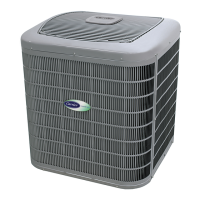Amber Status Light
An amber colored STATUS light is used to display the operation
mode and fault codes as specified in the troubleshooting section.
See Table 6 for codes and definitions.
NOTE: Only one code will be displayed on the outdoor unit
control board (the most recent, with the highest priority).
Utility Interface
With Infinity Control
The utility curtailment relay should be wired between R and Y2
connections on the control board for Infinity Communicating
Systems only (see Fig. 6.) This input allows a power utility device
to interrupt compressor operation during peak load periods. When
the utility sends a signal to shut the system down, the User
Interface will display, "Curtailment Active".
One Minute Stage Change Time Delay on 25HNA6
Models
When compressor changes stages from high to low or low to high,
there is a l-minute time delay before compressor restarts. The
outdoor fan motor remains running.
Compressor Operation on 25HNA6 Models
When the compressor operates in high stage operation, the
compressor motor rotates clockwise. Both the lower and upper
pistons are eccentric with the rotating crankshaft and both
compress refrigerant.
When the compressor operates in low stage operation, the
compressor motor reverses direction (rotates counterclockwise).
The lower piston becomes idle and the upper piston compresses
refrigerant. The start and run windings are reversed.
Crankcase Heater Operation
The crankcase heater is energized during unit off cycle regardless
of outside air temperature (OAT) on 25HNA6 models.
The crankcase heater is energized during off cycle below 65°F
(18.33°C) on 25HNA9 models.
Outdoor Fan Motor Operation
The outdoor unit control energizes outdoor fan anytime
compressor is operating, except for defrost or low-ambient
cooling. The outdoor fan remains energized if a pressure switch or
compressor overload should open. Outdoor fan motor will
continue to operate for one minute after the compressor shuts off
when the outdoor ambient is greater than or equal to 100°F
(37.78°C). This reduces pressure differential for easier starting on
next cycle. On 25HNA6 models, the outdoor fan remains
energized during the l-minute compressor staging time delay.
On 25HNA6 models, the outdoor fan motor is a PSC type. A fan
relay on the control board turns the fan off and on by opening and
closing a high voltage circuit to the motor. It does not change
speeds between low and high stage operation.
On 25HNA9 models, the outdoor fan is an ECM type. The motor
control is continuously powered with high voltage. The motor
speed is determined by electrical pulses provided by the PWM
outputs on the control board. The ECM motor RPM adjusts to
outdoor conditions as described in Table 3. The PWM output can
be measured with a volt meter set to DC volts.
In low ambient cooling (below 55°F/12.78°C) on 25HNA6 and
25HNA9 models, the control board cycles the fan off and on.
Table 3 - Outdoor Fan Motor PWM Above 55°F(12.78°C)
Outdoor Temp (DC volts, Tolerance +/- 2%)
Model
25HNA924
25HNA966
25HNA948
25HNA960
Low Staae
(OAT_t 04 °F /
40°C)
8.72
9.06
9.91
10.83
Hiah Staae
(OAT_104 ° F /
40°()
9.35
10.26
11.04
11.7
Low & Hiah
Sta_ag__
(OAT> t 04 ° F /
40°C)
11.9
11.9
11.9
11.9
NOTE: For 25HNA9 models in low-ambient cooling, the PWMoutput for
both high- and low-stage equals the value for low-stage opera-
tion below 104°F (40°C).
Time Delays
The unit time delays include:
• Five minute time delay to start cooling or heating operation
when there is a call from the thermostat or user interface. To
bypass this feature, momentarily short and release Forced
Defrost pins.
• Five minute compressor re-cycle delay on return from a
brown-out condition.
• Two minute time delay to return to standby operation from last
valid conmmnication (with Infinity only).
• One minute time delay of outdoor fan at termination of cooling
mode when outdoor ambient is greater than or equal to 100°F
(37.78°C).
• Fifteen second delay at termination of defrost before the
auxiliary heat (Wl) is de-energized.
• Twenty second delay at termination of defrost before the outdoor
fan is energized.
• Thirty second compressor delay when quiet shift enabled.
• On 25HNA6 models there is a 1 minute time delay between
staging from low to high and from high to low capacity. On
25HNA9 models there is no delay; the compressor will change
from low to high and from high to low capacity "on the fly" to
meet the demand.
Compressor Operation on 25HNA9 Models:
The basic scroll design has been modified with the addition of an
internal unloading mechanism that opens a by-pass port in the first
compression pocket, effectively reducing the displacement of the
scroll. The opening and closing of the by-pass port is controlled
by an internal electrically operated solenoid. The modulated scroll
uses a single step of unloading to go from full capacity to
approximately 67% capacity.
A single speed, high efficiency motor continues to run while the
scroll modulates between the two capacity steps. Modulation is
achieved by venting a portion of the gas in the first suction pocket
back to the low side of the compressor, thereby reducing the
effective displacement of the compressor.
Full capacity is achieved by blocking these vents, thus increasing
the displacement to 100%. A DC solenoid in the compressor
controlled by a rectified 24 volt AC signal in the external solenoid
plug moves the slider ring that covers and uncovers these vents.
The vent covers are arranged in such a manner that the compressor
operates at approximately 67% capacity when the solenoid is not
energized and 100% capacity when the solenoid is energized. The
loading and unloading of the two step scroll is done "on the fly"
without shutting off the motor between steps.
NOTE: 67% compressor capacity translates to approximately
75% cooling or heating capacity at the indoor coil.
The compressor will always start unloaded and stay unloaded for
five seconds even when the thermostat is calling for high stage
capacity.

